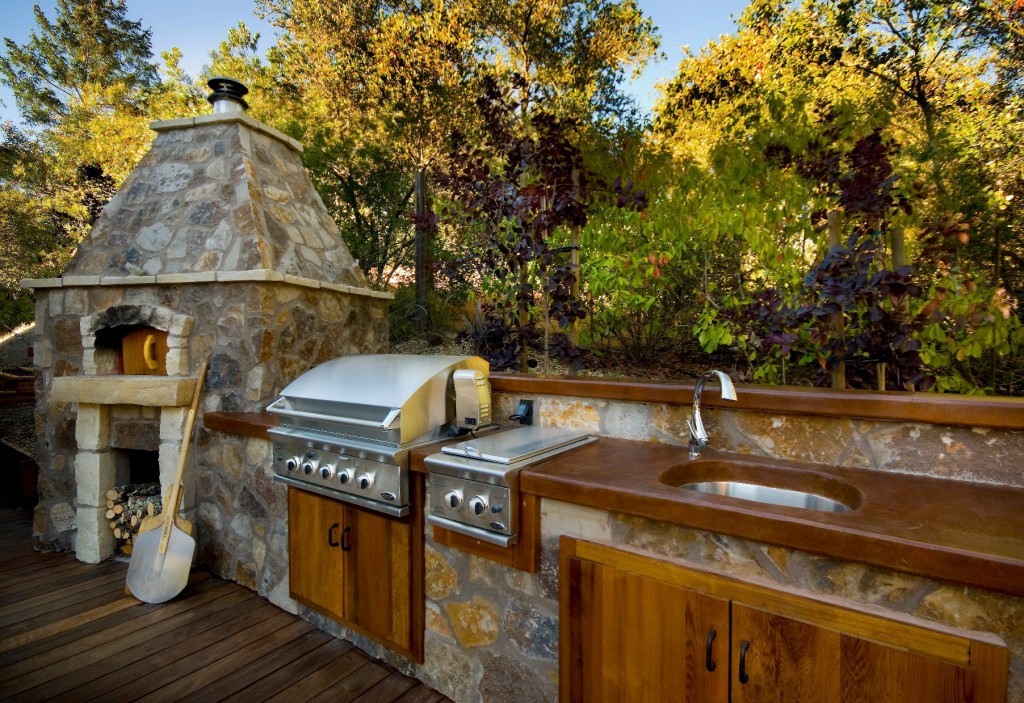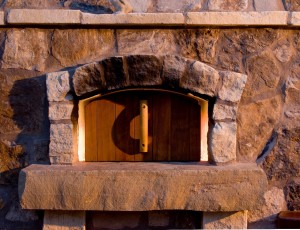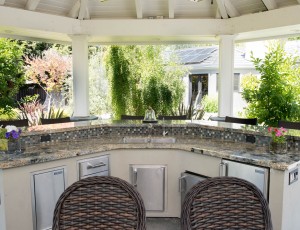All About Outdoor Kitchens

If you enjoy dining alfresco, an outdoor kitchen can double your pleasure by allowing you to cook outside as well. Photo: Riptide Construction, Inc. (2016)
With the beautiful weather in the Bay Area, it’s no wonder that one of the biggest local home improvement trends is to extend one’s living space to the outside with add-ons like decks and covered patios. However, even though these exterior additions are great, you can take your alfresco experience to a whole new level by building an outdoor kitchen, which will allow you to prepare meals and dine under the sun or stars. To learn about the process of outdoor kitchen construction, we’re joined by North Bay Area landscaping contractor Alain Joske.
Plan way in advance. An outdoor kitchen isn’t built overnight—it’s a lengthy process, and the actual construction is often the shortest part. As Mr. Joske explains, the most time-intensive portion tends to be the planning stage, during which the design is drawn and approved. “The length of the planning phase depends on a few factors, such as how busy your architect is and the legal restrictions of the area you live in,” he says. “For example, in Marin, your project might have to go through a design review, which could take several months or even a year.” For this reason, if you want your outdoor kitchen to be ready by summer, Mr. Joske suggests getting started the preceding fall, with the goal of beginning construction in January.
Design smart. While it may not be as exciting as the actual construction, Mr. Joske says the design phase is the most critical stage of building an outdoor kitchen, which is why it should be taken slowly. “It’s important to take your time when planning your outdoor kitchen, because if you try to rush through it, you’re likely to miss something. Once it’s built, it’s a lot harder to change things than when it’s still on paper.”
One practical design consideration Mr. Joske recommends is building your outdoor kitchen in close proximity to your indoor kitchen. “An outdoor kitchen is a lot like a hot tub: if it’s situated near your home, you’re more likely to use it than if it’s 100 feet away. You want it relatively close to your indoor kitchen so you can carry your food and dishes back and forth with minimal inconvenience.”

From stone pizza ovens to paella burners, the sky’s the limit when it comes to outdoor kitchen features. Photo: Riptide Construction, Inc. (2016)
Consider your options. When it comes to choosing cooking features for your outdoor kitchen, the grill is just the beginning. As Mr. Joske affirms, there’s an almost limitless range of options to maximize your culinary possibilities. “Last year, I did an outdoor kitchen that had a grill, a pizza oven, a paella burner and a smoker—not to mention a refrigerator and an ice maker. Needless to say, there are a lot of options.”
In addition to thinking about the features you want, it’s important to consider the specifications of each. For example, when choosing a barbeque grill, you can go with either a conventional gas-powered model or a more modern innovation like an infrared cooker. “There are high-end grills now that use infrared lamps to cook food,” explains Mr. Joske. “I’ve never used one, but a lot of people love them.”
Mr. Joske also suggests thinking about features that aren’t food-related, such as built-in stereo speakers and LED lighting. “Lighting is a big deal when it comes to outdoor kitchens, because if it’s dark out, you need to be able to see what you’re doing.”
Build it to last. Since you’re building outside, you’ll want to use materials that will stand up to the elements. Mr. Joske describes some typical options: “On the construction end, the most common material choice for an outdoor kitchen is something cementitious, like poured-in-place or block concrete. Alternately, you can build a wood framing and apply stucco or a veneer stone facing over it. For countertops, you have the choice of poured-in-place concrete, stone or tile. It really just depends on your budget and what you’re looking for.”
In addition to hardy structural elements, you’ll want to choose durable appliances, especially since replacing them can be a hassle. “Depending on the design, replacing appliances in an outdoor kitchen can be pretty involved,” says Mr. Joske. “For instance, if you have a stone facing that’s clad over the mounting edge, you won’t be able to just pull out the old grill and drop in a new one—you’ll have to tweak things a bit. So, your best bet is to avoid this by choosing quality appliances that will go the distance.”

To ensure long-lasting performance, invest in durable materials and appliances for your outdoor kitchen. Photo: Building Pros (2016)
Maximize your budget. According to Mr. Joske, the average cost of an outdoor kitchen project is between $60,000 and $80,000, although it can be higher depending on the materials and appliances you choose. He offers a couple of tips for minimizing costs: “One simple way to save money is to buy the appliances and equipment yourself so you don’t have to pay the contractor’s markup. Another is to choose economically priced materials. Stucco facing is a lot cheaper than veneer stone, and tile countertops are cheaper than poured-in-place concrete, so these material choices can make a big difference in the cost.”
Don’t forget ongoing maintenance. Outdoor kitchens are designed to be low-maintenance, but that doesn’t mean they’re “no-maintenance.” Mr. Joske says that in order to keep your outdoor kitchen in good shape, you need to do yearly maintenance. “Take your countertops: concrete tops need to be oiled annually and stone or tile tops need to be resealed regularly to prevent staining.” He also recommends periodically pulling out and cleaning behind appliances like your refrigerator, which will help keep them running efficiently.
By planning ahead, choosing the right features and materials, and keeping up with ongoing maintenance, you can have an outdoor kitchen that you’ll enjoy for many years.
To find a Diamond Certified contractor that builds outdoor kitchens, visit www.diamondcertified.org.